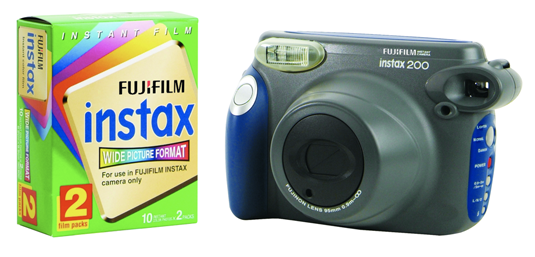Back in February, the modern-day Polaroid company announced that it was ceasing production of instant film, thereby bringing an end to the business that made Polaroid Polaroid. It was a sad day for what was once one of the coolest consumer technologies going, and when I blogged a heartfelt tribute a lot of folks chimed in with their own memories.
Polaroid photography is, I’m sorry to say, still dead. Permanently, probably. But I’m tickled to report that instant photography is back, in the form of Fujifilm’s Instax 200 camera. Yup, a camera of the sort that takes film and spits out photos that develop as you watch.
Fuji says that its heard from police officers, real estate agents, healthcare providers, and others who have grown panicky over the dwindling supplies of Polaroid film, and so the company is rolling out the Instax in the U.S. for the first time. Fuji’s system isn’t Polaroid-compatible, but it’s very much Polaroidesque. The camera is $69.99; a 20-pack of film is $28.99. Both will be available in December.
I’m curious just what sort of cops, realtors, and doctors are still using Polaroid cameras, and whether they have rational explanations for ignoring the digital photography revolution which has been underway for a decade or so. If they’re merely hardcore luddites, that’s okay with me. But I was reminded of one virtue of instant photography recently when I had a passport photo taken: The photographer used a digital camera, and it took him ten minutes to download the photo, process it, and print it out. For all of digital photography’s profound usefulness, it’s not as instant as instant photography is.
One side note: Fuji’s Instax announcement comes just days after Japan’s Tomy announced a digital camera with a built-in photo printer. The Tomy product sounds intriguing–but it’s no more magical than the original instant camera that Polaroid founder Edwin Land released back in 1948. This is probably sacrilegious in the extreme, but I think it’s possible that Dr. Land would be happy to know that Fuji revived instant photography after Polaroid did its best to bump it off.



 I never expected to write as much about Polaroid cameras as
I never expected to write as much about Polaroid cameras as  Nikon announced four new point-and-shoot cameras today, one of which has a truly striking feature: a built-in projector. The $429
Nikon announced four new point-and-shoot cameras today, one of which has a truly striking feature: a built-in projector. The $429 